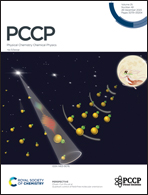DFT investigations of phenyldithiafulvene dimers at different oxidation states†
Abstract
Oxidative dimerization of aryl-substituted dithiafulvenes (Ar-DTFs) presents an efficient C–C bond forming method for the preparation of diverse redox-active π-conjugated molecules and conductive polymers. Previous experimental data indicated a reaction pathway in which direct combination of two Ar-DTF radical cations is a key step. However, mechanistic details about how Ar-DTF dimers are formed under different oxidation states have not yet been clearly established prior to this work. The assembly of two Ar-DTF molecules generates a vast conformational and configurational landscape, which is quite complex but fundamentally important for understanding the dimerization mechanism. To cast a deep insight into this aspect, we have performed density functional theory (DFT) calculations at the M06-2X/Def2-SVP level of theory to thoroughly investigate the potential energy surfaces (PESs) of various dimers of a phenyl-substituted dithiafulvene (Ph-DTF) in the mixed-valence radical cation and dication states. Key stationary points in these PESs, including minimum-energy conformers (π-dimers and σ-dimers) as well as the transition states connected to them, were examined and compared. We have also calculated the binding energies of these dimers to evaluate the energetic driving forces for their formation. Based on our computational results, the roles that various Ph-DTF dimers play in different pathways of oxidative dimerization have been clarified.



 Please wait while we load your content...
Please wait while we load your content...